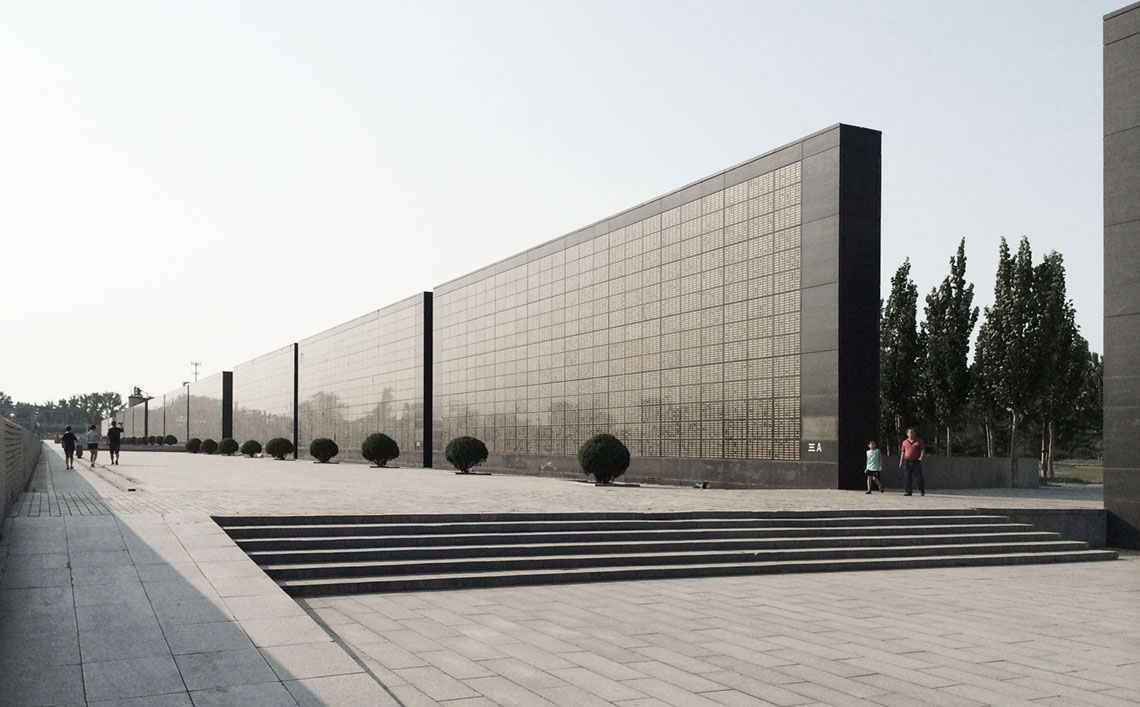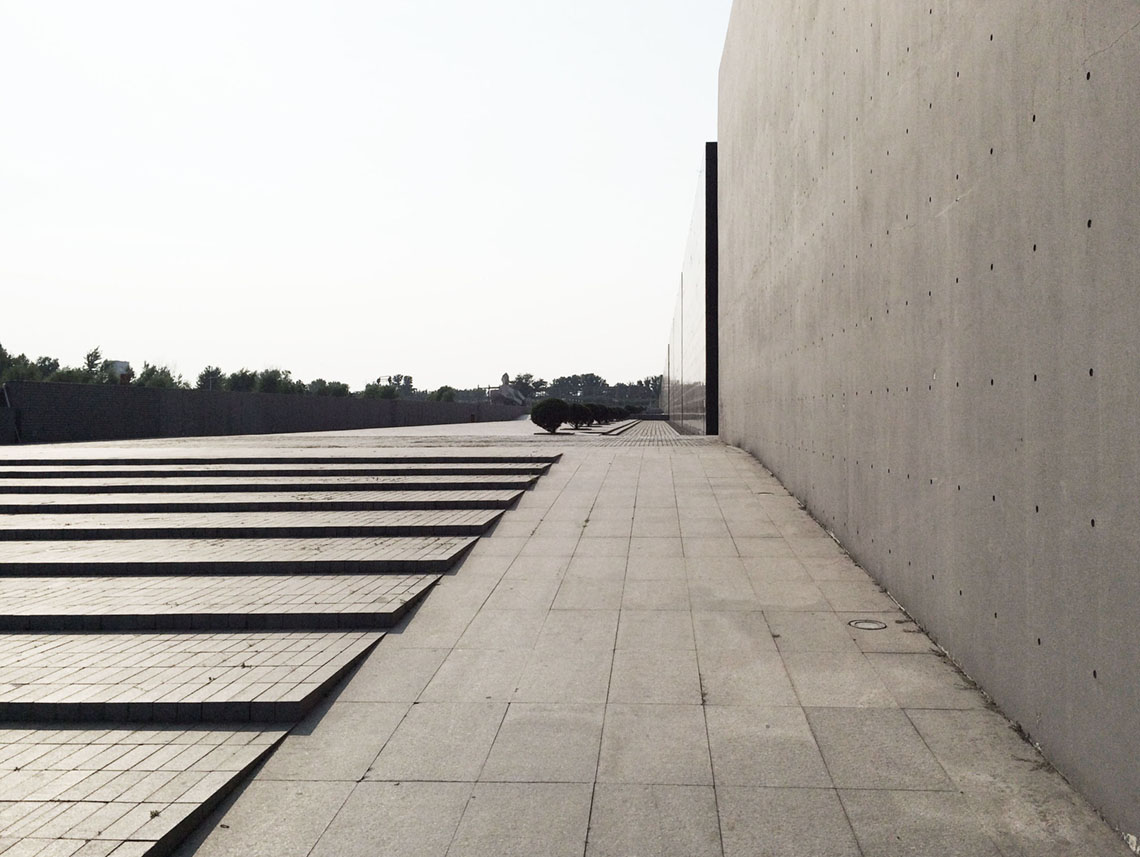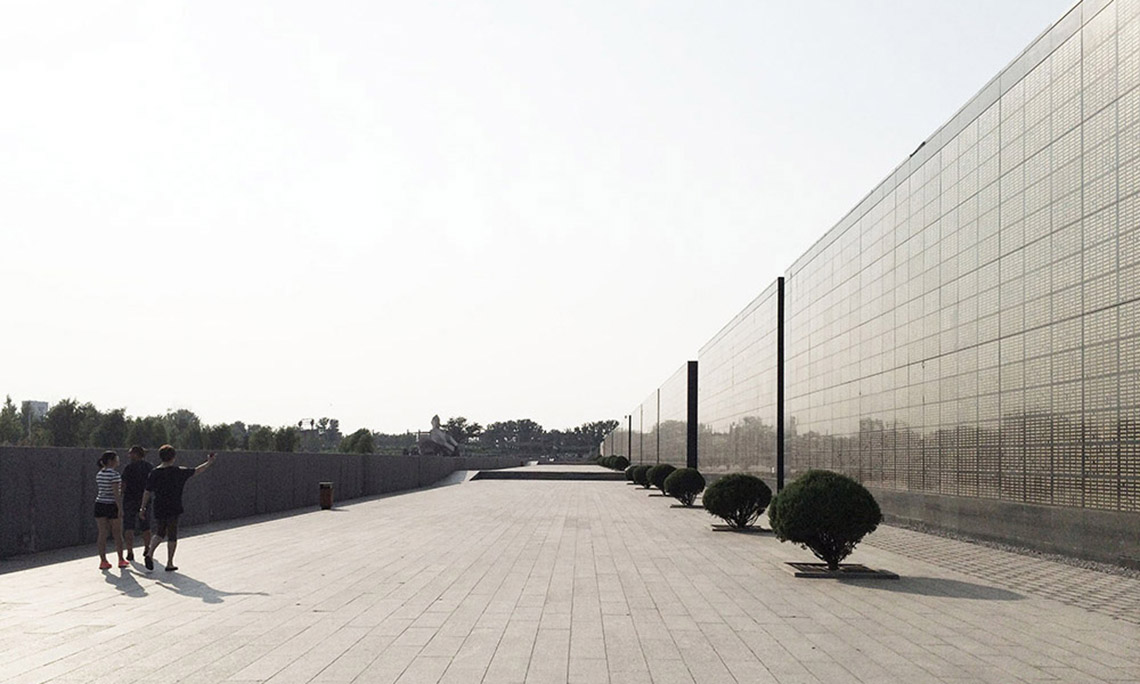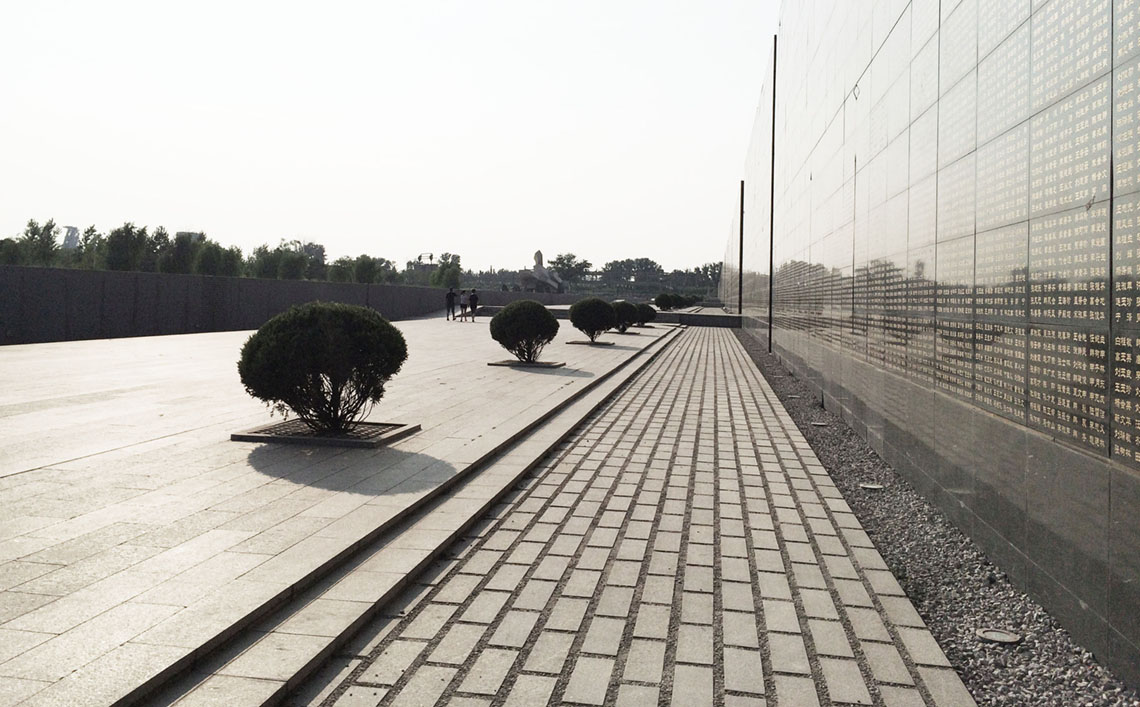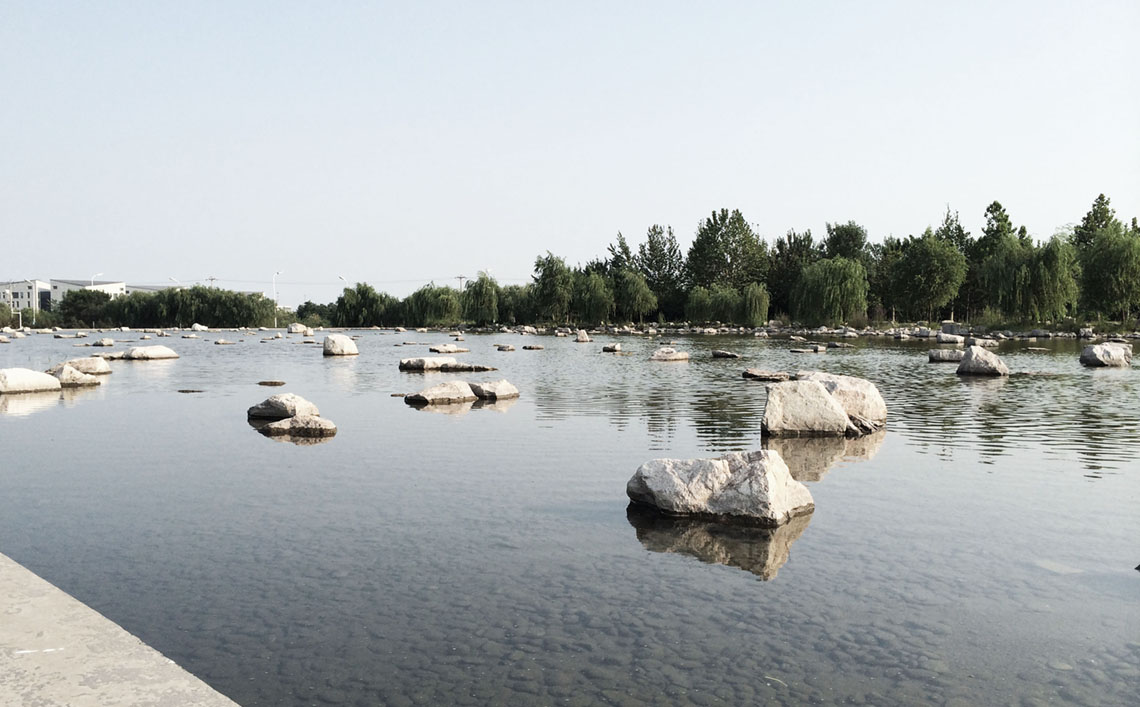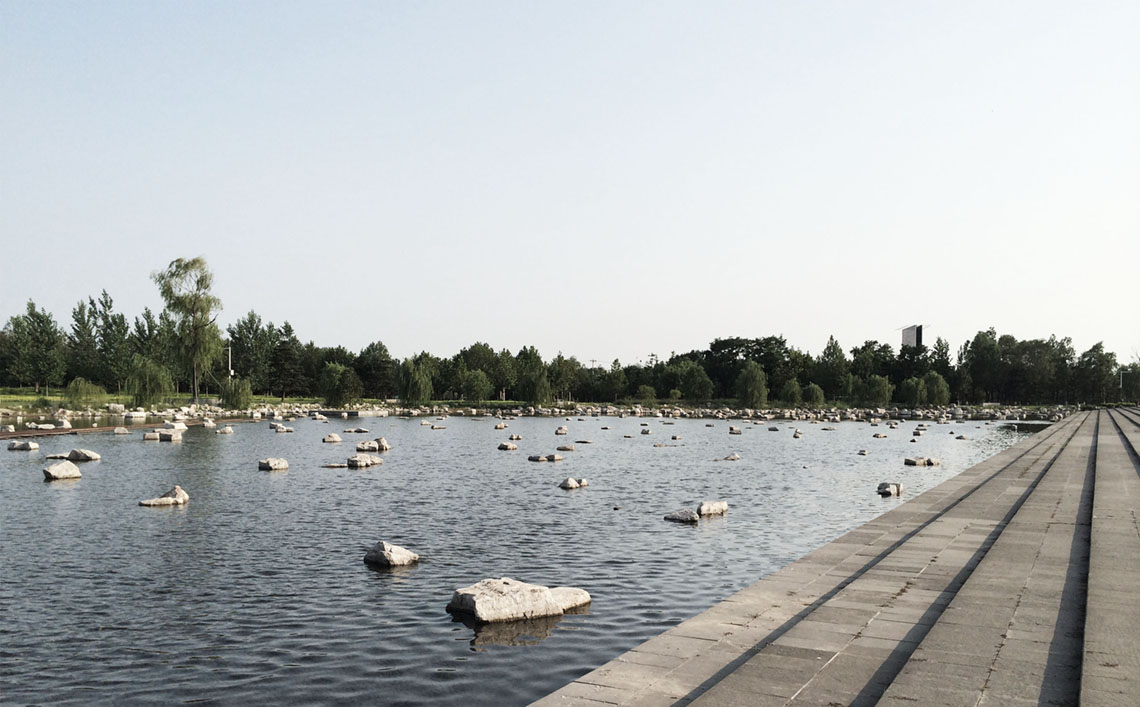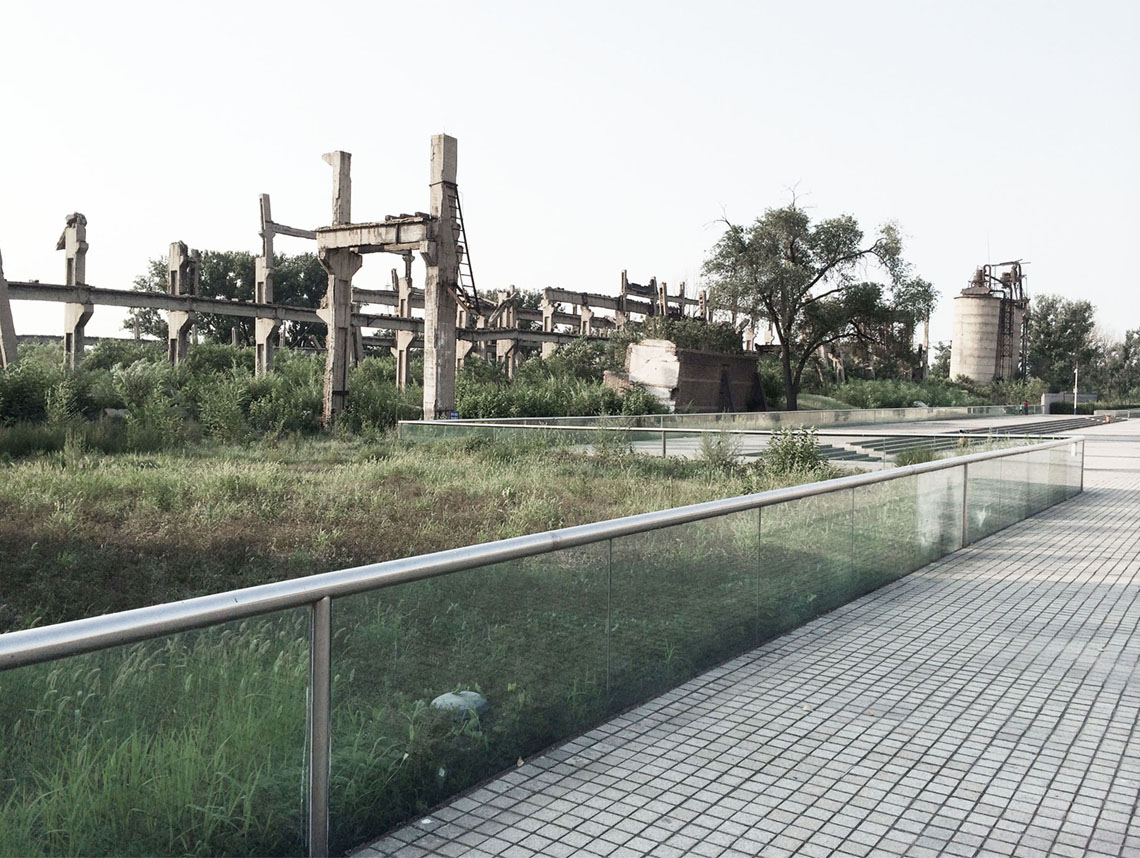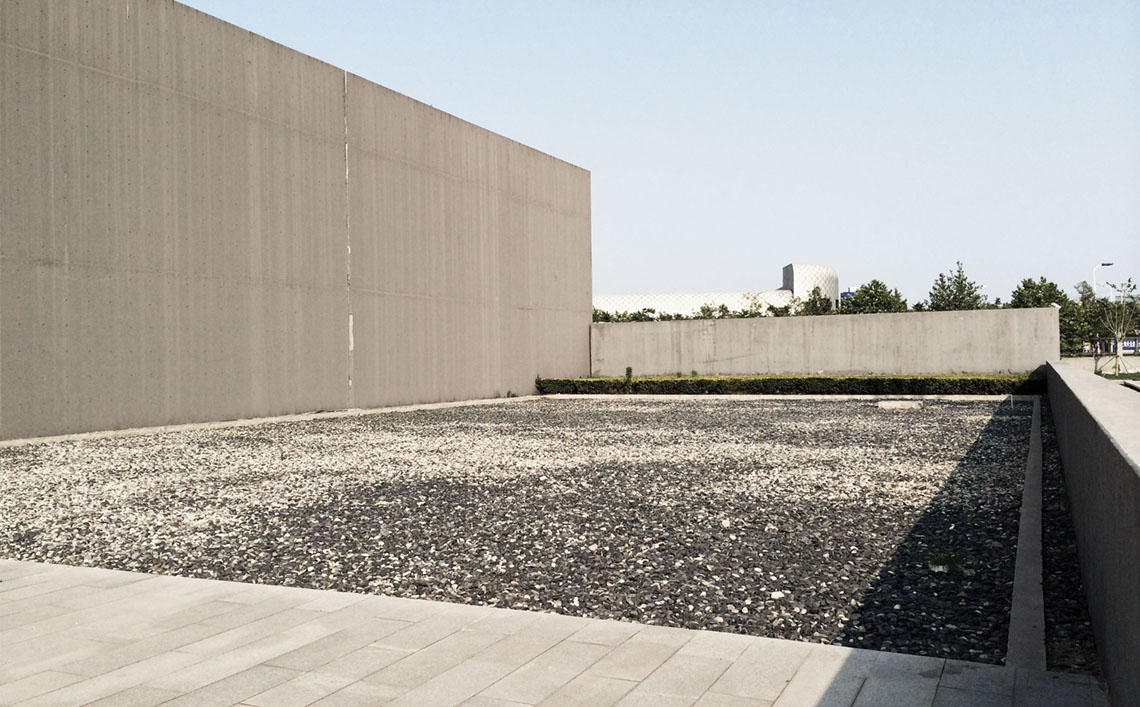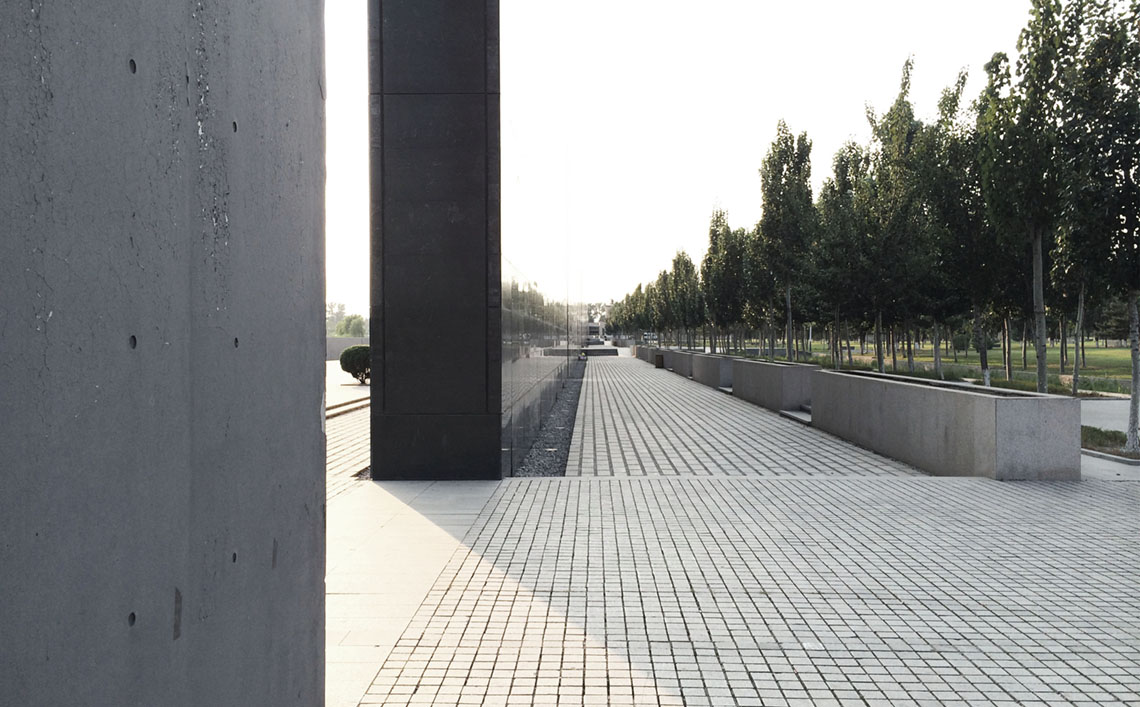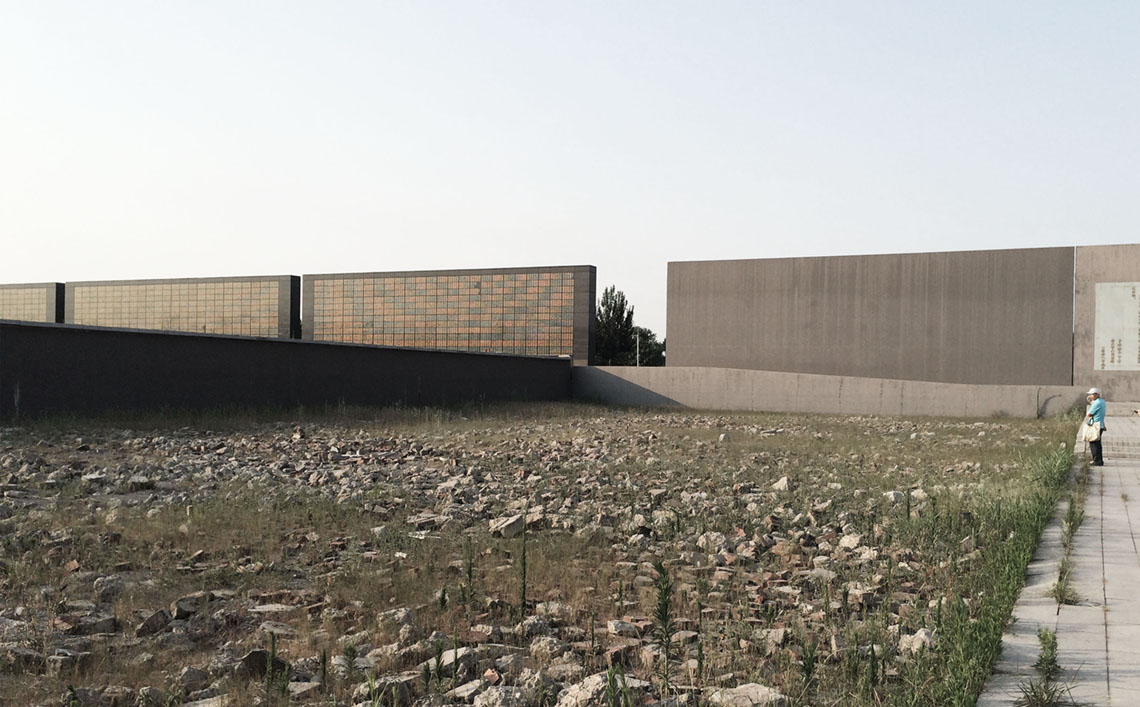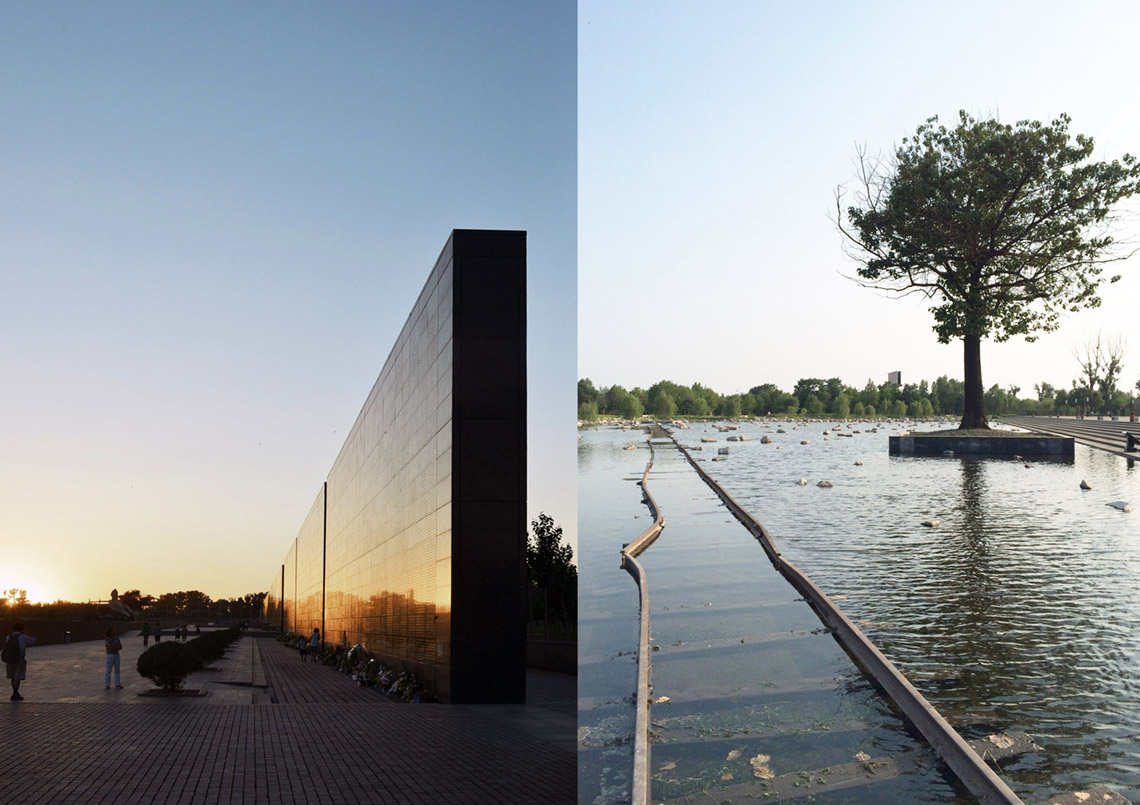Tangshan Earthquake Memorial Park
唐山地震遗址纪念公园
LOCATION: TANGSHAN
project year: 2007
STATUS: BUILT
The design exploits the potential advantages of the area to the greatest extent and separates water bodies from woods by means of the “Memorial Road” running through the area from south to north and leading to earthquake ruins as well as a memorial wall with a full length of nearly 400m. This new axis and another linear element on the area, i.e. an abandoned rail becoming distorted due to the earthquake, respectively run through the area from south to north and from east to west and divide the area into four parts, i.e. ruins square area, water area, forest area and rubble area. The intersection of the two axes is on the border of the ruins square, the earthquake memorial hall and the earthquake science museum are appropriately located in this core of the intersection, and the intersection becomes the ending point of the “Memorial Road” and the starting point of the ruins square.
The memorial wall is the world’s biggest tombstone for earthquake victims. The names of 240,000 victims are carved onto a polished black granite wall surface in a homogenized way. The memorial wall is not only a guide to the “Memorial Road”, but also the condensate of spirit. The black granite wall carved with names all over “cuts” the whole area, enhances the characteristics of the area from south to north, appropriately defines the position of the main entrance, endows the park’s commemorative activities with a clear direction, and maintains the primary structure and completeness of the area to the greatest extent. The memorial wall has huge dimensions enough to govern the whole park space and symbolizes the anniversary of the earthquake, i.e. July 28, with the average height of 7.28m. The highly polished black granite wall reflects the sky, the earth, surrounding sceneries, and visitors, which are integrated with the golden names of 240,000 victims, so that it gives people a shaky feeling.
The entrance of the park is a sunken square. When people go downward, they will feel low-spirited and calm, which heralds the beginning of an unusual memorial road. In the corner of the sunken square, there is an intentionally planted gingko tree, which seems very special on the empty square and hints the correlation with the Foxglove tree on the water at the end of the “Memorial Road”. Go round the parapet carved with “Tangshan Earthquake Ruins Memorial Park”, people will see a relic square, where the rubble are like the fragments of the earthquake site and present the theme of the park in a direct and abstract way. Walking further along, people will see a dark grey concrete wall covered by a bronze plate which is carved with commemorative inspirations. A large blank removes impurities in people’s feeling and makes people shift their attention to the memorial wall on the north side. Along this huge memorial wall, go upward on the long memorial road step by step, the open water on the west side will gradually emerge before people (since the entrance is sunken square, people’s eye level is below the water level; when people go upward on the memorial road step by step, the eye level will rise and the water will gradually emerge). The forest on the other side will appear repeatedly through narrow slits between walls. The sense of pressure will gradually release as the space becomes open, and the sense will reach a climax when people arrive at the ruins square.
At the end of the memorial road and the memorial wall, there is the ruins square, which shows the general view of earthquake ruins. The underground earthquake memorial hall and science museum are built on the west side of the square. A rail distorted in the earthquake is laid on the water, extends to the west, and gradually disappears in the water. The visitor can go along the rail and arrive at the center of the water. The two trees left on the water visually connect the ends of the rail and spatially contrast with the gingko tree planted on the sunken square at the entrance. When the visitor goes to the square from the memorial road and looks back, he will see a vast scene with the memorial wall as the border and the earthquake ruins as the background. All these make people rethink about the relation between life and the nature when directly feeling the destructive power of the earthquake.
The vast expanse of water on the west side of the Memorial Wall has a strong reflection surface, demonstrating its relation with the sky. The water expanse, the sky and the artificial space in the middle form a strong theme, namely, the relationship of the earth, the human being and nature. The design of the water surface impresses people with a visible, however, untouchable feeling, showing the distance between the living and the dead. The black pebbles spread under the water help to create an effect of unpredictable depth of the actually shallow water. Meanwhile, the scattered stones on the surface remind people of individual life struggling between survival and death, responding to the names of the departed on the Memorial Wall.
The design of the trees plays an essential role in expressing the commemorative meaning. The two rows of tall and orderly poplars behind the Memorial Wall are safeguards of life, while the woods on the whole indicate the meaning of tree burial and the circle of life. The thick and strong paulownias reserved on the waterside are just like life totem, symbolizing the mightiness of life. Meanwhile, the lonely tree at the end of the rail indicates the other world. The trees arrays on the roof of underground memorial have even richer symbolic meanings, showing the tenacity of life and the infinite hope for the future.
To the national key cultural relics—the former Tangshan Locomotive and Rolling Stock Works’ earthquake relics, we adopted the strategy of no moving so that the relics could be kept intact, and that the buildings and landscapes before the earthquake could be preserved to the highest limit. In this way, the relics could be preserved and the real history could be presented to the world. Apart from preserving the relics left before the earthquake as intact as possible, we believe that we should selectively keep the traces of rebuilding after the earthquake, including plants landscape, architecture, facilities and roads. Therefore, the original texture on the area is preserved, and new landscape elements were planted on the old area. Here, the old and the new present their distinctive characteristics and exist in harmony.
Since the completion of Tangshan Earthquake Memorial Park in 2008, numerous residents of Tangshan have come to commemorate their late relatives on almost all the important festivals, such as the Earthquake Memorial Dayon July 28th, the Tomb-Sweeping Day (Qingming) and Spring Festival. This park has become the most important earthquake memorial place in Tangshan and the spiritual sustenance for people in Tangshan. Many party and national leaders including Xi Jinping, Li Keqiang and Wen Jiabao, and a large number of domestic and international well-known people have come and paid a visit to this park. In 2010, the movie “Aftershock” was shot in the park, with its core landscape being the ending scene, which has left deep impression on Chinese people with its meaningful scene. In June 2011, the park was listed as a classical tourist attraction of national red tourism. And in July 2011, it was awarded with the title of demonstration base for science popularization education of national earthquake prevention and disaster reduction.
With its extremely simple planning design, pure and strong visual spatial effect, delicate and meaningful landscape design, low-key and refrained architecture processing of relics and memorial landscape, Tangshan Earthquake Memorial Park provides a memorial space environment with artistry, humanism and long-term social value, and realize architect’s ultimate ideal of serving the society with architecture design.
该设计挖掘了基地的潜在优势,通过一条贯穿基地南北最大纵深并通向地震遗址的“纪念之路”和总长近400米的纪念墙把水体和树林分开。这条新的轴线与基地原有的另一个线性要素——被地震力破坏扭曲的废弃铁轨,分别贯穿基地南北和东西两个方向,从而把整个基地分为四个部分:遗址广场区,水区,林区,碎石区。两条轴线的交点正处于遗址广场的边缘,地震纪念馆和地震科普馆恰到好处地设置于该核心位置,成为纪念之路的终点和遗址广场的起点。
作为世界上最大的地震死难者的墓碑,24万死难者名字以一种“匀质化”的方式刻在抛光的黑色花岗岩墙面上;纪念墙既是“纪念之路”的引导,也是精神的凝聚体。刻满名字的黑色花岗岩墙体“切割”了整个基地,强化了基地纵深方向的特征,恰当地定义了主入口的位置,并给公园的纪念活动以明确的方向感,同时最大限度保持了基地的原始结构特征和完整性。纪念墙具有统御整个公园空间的巨大尺度,并以7.28米的平均高度象征地震纪念日7月28日。高度抛光的黑色花岗岩墙体将天空、大地、周围景物以及参观瞻仰的人影反射于其中,与24万死难者的金色名字融为一体,给人以强烈的震撼。
公园的入口是一个缓步下沉的广场,当人向下走的时候,情绪会变得低沉而平静,这预示着一段不寻常的纪念之路的开始。下沉广场角落有意种植一棵银杏树,在空旷的广场上颇具意味,也暗示了对纪念路尽端水面上那棵泡桐树的关联。转过刻有“唐山地震遗址公园”的矮墙,出现一个废墟广场,碎石瓦砾如同是地震现场的片段,以直接但抽象化的手法呈现出地震的主题。再转过去,是一堵刻有纪念铭文青铜板的黑灰色混凝土墙,大面的空白清除了人情感中的杂质,并将注意力开始转向北侧的纪念墙。顺着巨大的纪念墙,在这漫长的纪念路上逐级而上,西侧的开阔水面会渐渐浮现于眼前(入口处由于下沉的处理,人的视线在水面标高以下,当人沿着纪念路逐级而上,视线随之升高,水面则慢慢显现);另一侧的树林会通过墙体之间的狭缝反复出现,压迫感随着空间的逐渐开阔开始慢慢释放,直至遗址广场,达到高潮。
纪念路和纪念墙的尽端是遗址纪念广场,展现出地震遗址的全貌。地下地震纪念馆和科普馆建在广场的西侧。有一段地震时被震弯的铁轨铺在水面上,向西延伸并渐渐消失在水中,参观者可以顺着它走到水面中央。留在水面上的两棵树,在视觉上将铁轨的两端联系起来,并与入口下沉广场孤植的银杏树形成时空的对照。当由纪念路转向广场并回望,形成一个以纪念墙为边界的广阔场景,而背景就是地震遗址。这一切让人在直接感受地震破坏力的同时,会对生命和自然的关系产生反思。
纪念墙西侧巨大的水面表现出与天空的关系,具有很强的反射面,与天空及中间的人造空间形成一个强烈的主题,即大地、人和自然之间的关系;水面的设计可以给人一种可望而不可及的感觉,表达出逝者与生者之间的距离。水下铺满的黑色卵石使得浅浅的水池产生深不可测的效果,而水面上散落的石头则令人想到个体生命处于生死之间的命运,并与纪念墙上的逝者名字形成对照。
“树”的设计在表达纪念性上起到“点睛”的作用。纪念墙后面的两排高大整齐的杨树如同对生命的护卫,而整片的树林则有“树葬”和生生不息之意;水边保留的粗壮有力的泡桐树如同生命的图腾,象征生命之强大,而铁轨尽端的孤树则有“此案彼岸”的意味。地下纪念馆屋顶上的树阵更富象征意义,寓意了生命的顽强和面向未来的无限希望。
对于国家级重点文物——原机车车辆厂地震遗址,我们采取“不动”的策略,使得遗址原封不动的保留下来,最大限度保留震前建筑及景观,保护遗址,使真实的历史呈现;除了尽可能完整保留地震前留下的遗迹,我们认为还应该有选择地保留地震后建设的痕迹,包括植物景观、建筑、设施和道路。于是基地上原有肌理被保留了下来,并在此基础上将新的景观元素“种”在旧的基址上。“新与旧”在这里呈现出各自鲜明的特征,和谐共存,融为一体。
唐山地震遗址公园自2008年建成以来,每年的728地震纪念日、清明、春节等重要节日,无数唐山市民来此祭奠逝去的亲人,这里已成为唐山市最重要的地震纪念场所和唐山人的精神寄托之所。习近平、李克强、温家宝等多位党和国家领导人及大量国内外知名人士先后来此参观视察。2010年,电影《唐山大地震》在地震遗址公园取景,并将公园核心景观作为电影的结尾镜头场景,其意味深长的画面给国人留下深刻印象。2011年6月,公园被列入“全国红色旅游经典景区”名录。2011年7月,公园被中国地震局授予“国家防震减灾科普教育示范基地”称号。


